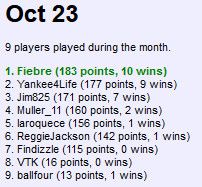-
Posts
21505 -
Joined
-
Days Won
82
Content Type
Profiles
Forums
Downloads
Everything posted by Yankee4Life
-
4 out of 10, 76 seconds. I was completely lost in this one and the only thing that saved me was guessing four of them right. When they ask me Nascar and soccer questions I am beaten. How do I know where Dale Earnhart is from? I never was interested enough to find out. Maybe you didn't get any of those under forty seconds scores but you got enough to keep pace and win. You have always done good in this trivia.
-
6 out of 10, 94 seconds. Like Jim, i was lucky to get that many correct. These were tough. Ok, here is our winner for the month of October. Congratulations Fiebre. He won this month with room to spare. I actually had the lead for the first half of the month and I said to myself if I just remained consistent I could win. Well that is exactly what I did. For the rest of the month I was consistently bad. 😄
-
Once again this week we look at a uniform modder whose mods were strictly for Mvp Baseball 2004 and a stadium creator for Mvp 2005 that whose work you probably have seen if you have played some of the more modern Total Classics mods. And our behind the scenes modder was a guy who worked in the in game audio department in the great Total Classics series. Ari Ari’s uniform work on this website has been buried in the download section for many years because the last mod he uploaded was in July of 2004 and it was for Mvp 2004, a game that gets no attention anymore because of the popularity of Mvp 2005. Even when Mvp ‘04 was thje only game in town around here Ari’s uniforms were overshadowed by other unform creators such as UMachines and KCCityStar, both of whom made uniforms for each team in the major leagues. Ari was a guy who made many alternate uniforms and I personally enjoyed putting them into my game. As a reminder you can use any of these uniforms in your Mvp 2005 game. Red Sox Uniform Pack One of the uniforms in the Red Sox uniform pack. There are four uniforms total. San Francisco (New York) Giants World Series Jerseys Mets Alternate Home Uniforms Devil Rays Alternate Away When you are asked to use Fuzzone’s Mvp Studio please disregard that. That was the ideal way to install uniforms back then and it was one of the best programs around to manage your uniform installations. Now please TiT to install the uniforms. EvilSelig With a name like that you know how this guy felt about the former commissioner. EvilSelig’s stadiums were stand-alone mods (they could be used in just about any mod or season available) or for particular editions of the Total Classics series. It’s true that when you think of stadium creators you think of guys like Pirate and Dennis James. But his work like Municipal Stadium in Cleveland and the Metrodome in Minneapolis take a back seat to no one. HHH Metrodome Cleveland Municipal Stadium Baltimore Memorial Stadium by Sean O updated by evilselig Safeco Field Behind the Scenes TxDodger73 Not a lot of people will recognize this name even though he has been a member here since April of ‘05 but TxDodger73 made a name for himself by working on the in game audio in the Total Classics series. He actually does have a handful of audio mods that he released but I don’t recommend you downloading them because they are already included in some of the season and classic mods.
-
This is really impressive for the questions that they ask for this round. I know what you mean.
-
5 out of 10, 56 seconds. My God these questions. I winged it today and am looking forward to November.
-
9 out of 10, 70 seconds. I should be happy with this am I right? No! I got the first nine questions right and the last one was a baseball card question. Here you are everyone, remember this answer so you don't get stumped on it.
-
A note to everyone here. This file is for High Heat Baseball 2004. Just a reminder for you all. I have not seen this mod in years and I am very grateful for it. JimtheUmp was actually an umpire when I met him over at the old High Heat forum. He was from New England and was a big Red Sox fan and during those years when that website was around I was a huge Yankee fan and I saw the world with pinstriped colored glasses on. You can say the bloom has fallen off the rose for me now because I don’t care about them anymore. The last I heard about him was that he got a job with Major League baseball and moved to Arizona. I always wished him well.
-
10 out of 10, 44 seconds. I need these kind of results the next two days for any kind of chance.
-
6 out of 10, 60 seconds. I need a miracle now to win this but Fiebre is on fire. 👍
-
10 out of 10, 38 seconds. Anytime I finish under forty seconds I am thrilled. I need to make one heck of a comeback these next few days.
-
6 out of 10, 112 seconds. For me in this category (General-Easier) this is outstanding because I hardly do well in it.
-
Congratulations to the Diamondbacks and the fact that they beat the Phillies was a bonus. Did you see how they won this series? 1.Sacrifice bunts. 2.Stolen bases. 3.Aggressive base running. Aggressive base running all the time. 4 Singles and line drive hits that advance runners and provide pressure on the opposition. 5. Consistent hustling defense. 6. Consistent starting pitching. Now do the Yankees do any of this?
-
8 out of 10, 55 seconds. Once again a baseball card question got me. Here it is so you all can remember it and take advantage of it the next time it comes up. I wouldn't pay a nickel for his cards. We have less than a week to go in this month's game and again it is very close.
-
3 out of 10, 134 seconds. What college did he go to, what is the name of a U.K. stadium and Australian rules football. You know, easy stuff like that. 😀
-
This week’s contribution of the best of the best includes a modder who made some very good mods for Mvp 2004, a modder who made some very good overlays for Mvp 2005 and our behind the scenes modder is once again someone who will be an unknown to newer people here. He did make a handful of mods but was mostly known for his help with the group of modders who made Mvp 2007 and 2008 over at EAmods with his work in the stadium department. Kamasutra All of Kamasutra’s mods were made for Mvp baseball 2004 and if you still have that game like I do you will discover that some mods were only made for that game and not for the more well known version that we still play today. His minor league ball park series was a set of mods I looked forward to when he was releasing them and they were very popular with Mvp ‘04 users. Combo Datafile Mod And New Cameras Custom Minors Stadium Included in this series are ball parks from Reading, Edmonton and Portland (among others.) Kamasutra’s RDS Overlay. Here is one I can almost guarantee that over 95% of you never heard of. RDS means Reseau Des Sports and it was one of the official broadcasting networks for the Montreal Expos. Torement Torement's work is for Mvp 2005 and made cyberfaces that, because of how many years have gone by, can only be see in the Mvp 2006 through 2008 total season conversion mods. He also dabbled in overlays both fantasy and real-life networks. Both of these contributions that are featured here are from two New York networks that do not broadcast Yankee baseball any more thanks to the YES Network. The fantasy overlays were done for the Toronto Blue Jays, San Diego Padres and Arizona Diamondbacks. WB 11 Overlay. MSG Overlay. Behind the Scenes ChicagoCubs720 Every once in awhile CC720 would release his own work and those could be found in mods based on his beloved Cubs. Not all the time, but mostly. He made two versions of Wrigley Field and if you played any of the earlier season mods you saw his work without knowing. His contributions to the 2007 and 2008 season mods lead by Krawitham to help organize and work on the stadiums in those two mods helped make those two mods a popular download and it is still true to this day. Wrigley Field 2006 Final Version. Wrigley Field 07.
-
8 out of 10, 74 seconds. I got stumped on who won the 2004 N.L. Cy Young award. The right answer was Roger Clemens. I haven't got one of those right yet. 🙁
-
10 out of 10, 45 seconds. So far everyone who has played today has a perfect score. There's nine more days left in this month. It's going to be close again!
-

Random Thoughts On A Sunday Morning Updated To 11-23
Yankee4Life replied to Yankee4Life's topic in Left Field (Off-Topic)
Updated to 10-22 ...Emily Dickinson once said that she liked the look of agony because she knew it was true. She wrote these words back in the 19th century but they can easily be used to describe the 2023 edition of the New York Yankees. The Yankees proved that their collapse during the second half of 2022 was no fluke because once Aaron Judge got hurt in the beginning of June nothing was the same. Last year they showed they could fall apart with Judge in the lineup as he raced towards a home run record. This year they showed they could do the same thing with him being injured. Spring training is for hope, autumn is for reality: Every year Yankee fans fall for this and I used to be just as bad. Remember the off season when they signed Gerrit Cole? They said that was all that they needed and they predicted a trip to the World Series before spring training even started. That worked out well. The New York tabloids are all about generating interest so people can read their columnists. They over hype everything and fans believe it all while the faults of each player are glossed over except when you read that “so-and-so” plans on having a bounce back year and has really been hitting the ball well. Expect to read that over and over about Stanton when February rolls around. As soon as the season starts you begin to see that the optimism and expectation that you saw in Florida fades away quickly and the real world starts to settle in and with that the sensibility about who and what this team really is. What happened to this team? What happened to a Yankee team that would take pitches and work the count and actually make the opposing pitcher labor out there? These guys go up there with one intent and that’s to hit the ball out of the park so their launch angle and home run distance get attention. How did the Yankees become so right-handed and so slow and unathletic? It happened right before our eyes and here is what we have. I’ve been part of the group of fans that want to see Cashman and Boone gone and never to return but I don’t expect that to take place. It’s going to take awhile to fix this mess. I’m talking about a few years. Baltimore and Tampa Bay are way ahead of them in every aspect of the game. They know how to play winning baseball and it shows. You may joke that winning baseball did not help them in the playoffs but when you win 101 games like Baltimore did and 99 like the Rays you can go into spring training with real optimism and not some that is generated by the New York Post and Daily News. ...A Phillies fan was denied entry into Citizens Bank Park not long ago when he attempted to get in with an emotional support alligator. The man tried to tell the Phils that the reptile has helped him in his battle with depression. For example when he goes grocery shopping all the aisles miraculously clear when he walks down them and when he is ready to check out a register opens up just to take care of him. He does admit though that it is hard for him to have a pizza delivered to his home because the alligator has become partial to pepperoni. The Phillies had a few reasons not to allow the alligator in beginning with common sense and secondly the game was a sellout that night so where was he going to sit? If this was in Tampa they could have given him a half section on the first base side and no one would have got near him but the Phillies were playing good ball and even if they weren’t there is the common sense thing again. Now they were tempted to have him sit in a fenced off section down the right field line and in case a call went against the Phillies the guy could have let the alligator loose on the umpires. ...Only the Yankees could have a pitcher throw a perfect game and then get thrown off the team before the season is over. The story was that Domingo German was so intoxicated that he caused a disturbance in the clubhouse. After that he was gone faster than a Giancarlo Stanton at-bat. You know, three pitches and back to the dugout. I understand that drinking too much is a serious issue but after watching almost every Yankees game this season I was considering hitting the bottle too. ...Hold your Bets, Dept: On September 1st through the 3rd the Yankees traveled to Houston for a three game set with the Astros and as a shock to everyone (including themselves) they won all three games. New York was going nowhere and in dead last in the American League Eastern division but you could have fooled anyone that watched those games because they played like anything but a last-place team. Houston must have been really upset when they landed in Dallas to play the Rangers to play Texas on September 4th through the 6th because all they did in those three games besides making all of them a one-sided affair was to score a total of thirty-nine runs and pound an incredible sixteen home runs. The sweep put them back in first place when they left town. With the way they were playing they wanted to stay right there. After beating the Padres two out of three when they returned home to Houston they had to play the last place Oakland Athletics next on September 11th through the 13th. The Athletics were well on their way to losing over one hundred games in 2023 but that didn’t prevent them from beating Houston in two out of the three games they played them. This one example from one team from just a thirteen-game span in their schedule is all the reasoning why I never bet on baseball. I don’t bet on other sports but since baseball is the one sport I am most involved in daily I see how betting places like Fan Duel, Draft Kings and Bet365 are always advertising and making it so easy to bet on baseball every night. You can just guess how much money those bookies won when the Athletics beat the Astros two games in a row because they knew that everyone who bet had their money on Houston. They cleaned up so much those two games they never had to use a broom. They made money on the Yankees too because who expected to see a sweep? But no where near as compared to Oakland. Well, they won their money and all the amateur Jimmy the Greeks out there are poorer. What are the odds of me betting next year? If you put your money on 0% you’re a winner. ...I was going to write about my contempt for analytics in baseball but I did not know how to start it until the Toronto Blue Jays provided me with the perfect example that I am sure everyone saw because it happened during a post-season playoff game. To me analytics is something that makes managers have to keep changing pitchers until they find one to lose the game. Blue Jay fans will agree and for Yankee fans this is old news after watching Aaron Boone do this as he continually managed the Yankees to a loss instead of a victory. But the Yankees are dead and gone for 2023 so this really is not focused on them. They’re part of the problem but not the whole problem. Toronto was playing in an elimination game after losing the first game to Minnesota and the score was 0-0 in the bottom of the fourth inning. Forget that pickoff play that nabbed Guerrero because it had not happened yet. This right here is what really cost the game and the season for Toronto. Toronto starter Jose Berrios was pitching well but he walked Royce Lewis to open the fourth. After Lewis two left-handed hitters were coming up and Jays manager John Schneider compared that emergency to hearing his car alarm go off at 3:00 in the morning. Out of the dugout he came and with the wave of an arm Berrios was taken out of the game and lefthander Yusei Kikuchi came trotting in. Berrios was pitching very well as he struck out five hitters in his three plus innings of work, walked none and only gave up three hits. In other words he was on his game. The Twins took advantage of this huge break and scored two runs in the inning as Berrios was the losing pitcher while he was sitting in the dugout wondering what just happened. Guerrero falling asleep at second base in the fifth didn’t lose the game for Toronto. Not having Berrios on the mound did. This move only made sense to Toronto’s analytics team because the way they look at baseball is if A happens then you must only do B and never C or D. How many times have you watched a game where everything did not fall in line perfectly from the first inning to the ninth? Never? That’s right and the Steve Urkels of every teams analytics department have been trying to show that it can be done if you just listen to them. This game is played by people and there are so many factors that determine a team winning or losing a game and a spreadsheet is not going to help you except to give you a reason to lift Berrios in the fourth inning. I may not be much of a fan of today’s game but I do have some faith in baseball and one thing I know is that baseball is and always has been a copy cat sport. Tony Larussa and his pitching coach came up with this pitch count religion and now everyone does it. Now everyone it seems gets Tommy John surgery whereas before many years back in the 70’s and 80’s pitch counts were not used and pitchers were healthier. Another one is the Rays using an “opener.” Do you notice that everyone does it now? I am waiting for a team with the insight to return to real baseball where the manager manages instead of following pre-game instructions. When one does it it’s going to catch on and the computer heads will go back in their basement to play Dungeons and Dragons. In closing I will give you one example of a manager using his instincts to win a game. This occurred many years before we were born but it is to me a perfect illustration of managing with your head. It was the seventh game of the 1952 World Series and the Yankees were holding on to a slim 4 - 2 lead. The game was played in Ebbets Field and the Dodgers were a very tough team to beat there and left handed pitchers especially had a hard time there because of all the right handed power the Dodgers had. Brooklyn loaded the bases with one out in the seventh and Casey Stengel brought in southpaw pitcher Bob Kuzava. Kuzava got Duke Snider and then Jackie Robinson to pop out to end the inning. He pitched scoreless ball in the eighth and ninth and the Yankees won the game and the series. Immediately after the game reporters ran to Stengel asking him why he kept Kuzava in to face Robinson in the seventh. Stengel explained that the reason why he kept him in was that Robinson had not seen hard throwing left handed pitchers much and he therefore could have trouble with the break of a left hander’s hard curve. And that is exactly what happened. A manager managing on his experience and instincts. It still can be done today. ...Moved, no forwarding address provided, Dept: If the percentage of women in the state of South Carolina goes down substantially in the coming years it is because of one thing. Some South Carolina Republicans are now considering abortion an offense that should be punishable by death. They’ve even gone and made it sound nice and official by calling it the “South Carolina Prenatal Equal Protection Act of 2023.” In a nutshell the term “person” would now include a fertilized egg at conception and if a woman who goes through with an abortion in that state would legally be eligible for the death penalty. Now if that doesn’t make young, single women and young couples from across the country to pack up and move to South Carolina nothing will. These legislators that propose these kind of bills always like to project how pro-life they are and how hard they work to be like that and how precious life is unless of course if you are a woman. ...Kelly Clarkson, who these days looks like she lives next door to a bakery, recently sang a profanity laced song about how she felt about her recent divorce from ex-husband Brandon Blackstock during a recent concert in Las Vegas. You see, she is still smarting after being forced to pay him a $1.3 million lump payment. Besides that, what really got her going was she has to pay him $45,601 per month in child and $115,000 in spousal support until January 31, 2024 despite the fact that she was given primary custody and her husband would only get the kids one weekend a month. No matter how you look at it that’s quite a lot of money and the good part about it is that he doesn’t have to live with her anymore and also does not have to restock the refrigerator every forty-eight hours. One day her kids are going to see this video clip on Youtube and they’re going to see her putting down their father and you’d be right in wondering what would be going through their minds after viewing it. If a male singer would get on stage and rant about this and use a slew of four-letter words about his ex-wife it would be considered toxic. For females it's considered empowering. ...A thirty-one-year-old Cleveland woman has been charged with murder after leaving her sixteen-month-old baby daughter home alone for ten days as she went on vacation. Read that again because I can’t make this stuff up. The baby was found unresponsive with no signs of trauma. Police investigators stated that “the child had been left alone and unattended for approximately ten days and had subsequently died.” The woman, Kristel Candelario, traveled to Puerto Rico and Detroit on vacation. Never in my life have I ever heard of anyone going to Detroit on vacation. She told police that when she arrived home she found her daughter to be extremely dehydrated. Really? You try not drinking for ten days and see how it’s like. She is being held in the Cuyahoga County Jail on a $1 million bond. It looks like she’ll be going on another vacation soon and this one will be much, much long than ten days. ...Over the summer there was a remake of Disney’s Haunted Mansion, the 2003 film starring Eddie Murphy. I didn’t know much about it except for the movie previews I saw on TV and Youtube but after reading what the director of the movie said about it I’m glad I didn’t part with my eight dollars. Director Justin Simien said that he wanted to make the movie “as black as possible.” I’m sure this is news to many of you in here because it certainly was to me when I came across the article. It was news because the whiners and complainers on Twitter (or whatever it’s called now) never said a word. What Simien said was fine with them. Now imagine if someone said that they wanted to make a movie "as white as possible" there would be a uproar and you would have damned well heard about it on every news channel and program in the country. The guy would have been immediately fired and then he would have been forced to say he was sorry over and over again on TV except of course on FOX. They’d consider him a hero. In the Eddie Murphy Haunted Mansion movie race was never mentioned in the casting. Now it is all about race with Disney, and when a director blatantly says that he wanted it "as black as possible" then it is no longer about the movie. It becomes the director’s pushed political agenda so he can make a statement and when he does that he is setting the movie up to fail. Well, in that way he was successful because the reviews as well as attendance were not good. I blame Disney for letting this happen and for looking the other way when he made this comment. They have spent $965 million on four of its most high-profile streaming and film flops this year but to be fair this movie was not one of them. But you have to consider if you lose almost one billion dollars you’d stop and look around and try to find out why. ...Now if any of you think I went to go and see that Barbie movie you all are out of your mind! 😄 ...You can count me in on the number of people who are not even casually interested in the relationship between Kansas City’s Travis Kelce and singer Taylor Swift. From what I can gather it is two people getting to know each other and that’s it. If there is anything else about it then I am clearly not seeing it. Maybe it’s because I am not a fan of either one of them. Kelce plays for the Chiefs and when you are a Raider fan no other explanation is necessary. And I do not see the attraction with Swift. The woman looks like a scarecrow with teeth. ...It takes courageous African-American women such as Letitia James and Fani Willis to take on a tyrant and a twenty-seven year old former aide who was brave enough to testify at the public hearings concerning the January 6th, 2021 Capitol attack to show that you can stand up to a person like that and not worry about being called names. It’s called backbone and we all have it although the senators of the GOP check theirs at the door since they have not used them in years. ...I would definitely want to spend an intimate weekend with Paige Spiranac. But getting her to agree to it is the part I haven't figured out yet. -
7 out of 10, 47 seconds. What made me stop and think for a bit was two questions from the 1995 World Series. I did not watch a lot of that series because if you remember the Yankees were eliminated by Seattle in the playoffs. That's why I didn't watch a lot of that series.
-
No, I had that before also.
-
You had a hell of a day! Yeah, in kindergarten.
-
9 out of 10, 57 seconds. I missed a question from the 1800's. Really? How's that easy? But all in all it was a very good day.
-
Good job Jim. You always do great in this category.
-
4 out of 10, 151 seconds. General questions yes, easier? No. I was asked where Marat Safin was from. I said America but I was wrong. The right answer is Russia. I also thought for some reason that Marat Safin was female. Wrong on that part too. And that is a good example of how bad I played today.
-
Charlie Dressen While common wisdom dictates that baseball games are won with bats, balls, and gloves, Charlie Dressen believed until his dying breath that any game could be won with brains. Well, any game could be won with his brains. And it’s not hard to see why. Few field leaders had the percentages figured better than Dressen, he believed, and no one could match the sheer volume of retrievable information he accumulated during his five decades in baseball. The right-handed batting and throwing Dressen’s first Organized Baseball contract was a Minor League deal with the 1919 Moline (Illinois) Plowboys of the Class B Three-I League. He got in forty-two games with the Plowboys, playing mostly at second base. He returned to the Three-I League in 1920, this time as a member of the Peoria (Illinois) Tractors. After the baseball season concluded Dressen returned to Decatur, where George Halas and Dutch Sternaman recruited him to play for the A.E. Staley Food Starch company football team. He appeared in four league games in 1920 for the Staleys, a precursor of the Chicago Bears. Dressen made his big-league debut as a pinch-hitter on April 17, 1925, and had his first hit nine days later, against Wilbur Cooper of the Cubs. He saw action at second, third, and the outfield for the third-place Reds, batting .274 in seventy-six games. A month into the 1926 season, Dressen took over at third base. He batted .266 and led the National League in assists at third base. Dressen had his finest big-league season in 1927, batting .292 and finishing among the league leaders in doubles, triples, and walks. But by 1929 his average had dipped to .244 and in 1930 he lost his starting job to young Tony Cuccinello. He split most of 1931 between the Minor League Baltimore Orioles and Minneapolis Millers. He knew he was nearing the end of the line; however, unlike most ballplayers, he was prepared. In 1932 Dressen was essentially without a job. When he learned in June that the Nashville Volunteers of the Class A Southern Association were in need of a new manager, he borrowed train fare from a friend and made Vols owner Fay Murray an offer he couldn’t refuse. There were seventy-seven games left on the schedule—if Dressen failed to win more than half of the remaining contests, Murray wouldn’t owe him a dime. On the final day of the season, Nashville’s record under Dressen stood at 38 and 38. Playing the Crackers in Atlanta, the Vols fell behind in the early innings. They rallied to win, so Dressen got paid. He also got a one-year deal to manage the club and play third base in 1933. It was as manager of the Vols that he earned a reputation for an encyclopedic knowledge of player tendencies and situational statistics. In July of 1934 with the Reds twenty-nine games under .500, player-manager Bob O’Farrell was dealt to the Cubs. Dressen was offered the job. He quit his post at Nashville and took the managerial reins in Cincinnati. He didn’t do much better than O’Farrell, as the Reds finished in last place. Dressen piloted Cincinnati to a sixth-place finish in 1935 and a fifth-place finish in 1936. In 1937 the Reds tumbled into the cellar again, and when Dressen demanded to know his status for 1938, he was let go with a month left in the season. Consequently, he returned to Nashville, now a Dodgers affiliate in ‘38, and guided the team to a second place finish. Larry MacPhail, former Reds general manager and now in a similar role in Brooklyn, added Dressen to Leo Durocher’s staff as a third-base coach for 1939. The 1939 Dodgers were a ballclub on the rise. After a seventh-place finish in 1938, the 1939 team finished third, followed by a second-place finish in 1940. In 1941 the Dodgers outlasted the St. Louis Cardinals in a pennant race that went down to the wire. Durocher called the shots for this remarkable club, but rarely without input from Dressen. Branch Rickey, who replaced MacPhail as Brooklyn’s president after the 1942 season, apparently did not appreciate Dressen’s fondness for horse racing. When Charlie refused to swear off gambling, Rickey fired him in November of 1942. In July 1943, with Dressen staying away from the track, Rickey rehired him and he remained with the Dodgers through the 1946 season. One of Dressen’s special talents was his ability to steal opponents’ signs. From his vantage point on the coaching lines he was often able to make out how many fingers the catcher was putting down, and then inconspicuously relay this information to the batter as the pitcher began his windup. This could be risky to the batter if the batterymates became suspicious, particularly in the days before batting helmets. Once when Joe DiMaggio was at the plate, Dressen flashed the sign for a curve. The pitch was a fastball up and in; only DiMaggio’s catlike reflexes enabled him to avoid a beaning. He cursed Charlie after the at bat and ignored his signs thereafter. The Bronx Bombers faltered in 1948, finishing behind the Indians and Red Sox. Dressen’s protector, Larry MacPhail, sold his share in the team, so it came as no surprise when Charlie was let go by general manager George Weiss, who never really considered him “Yankee material.” Harris was shown the door, too. The new hire was Casey Stengel, with Dressen grabbing the managing job Stengel left, with the Oakland Oaks of the Pacific Coast League. Dressen guided the Oaks to a second-place finish in 1949 and a PCL pennant in 1950. That winter the call came from Brooklyn again. This time the Dodgers wanted Dressen to be their manager. He inherited one of the most talented rosters in National League history, one that included Gil Hodges, Jackie Robinson, Pee Wee Reese, Carl Furillo, Duke Snider, Roy Campanella, Don Newcombe, Preacher Roe, and Carl Erskine. Dressen did much of his managing from the third-base coaching box with 1951 Dodgers. Under his guidance the team held a double-digit lead over the second-place Giants in mid-August. Then things began to tighten up. The Giants came roaring back and, under pressure, the Dodgers dropped six of their last ten to finish the regular season in a first-place tie. A best-of-three playoff ensued, with a coin flip to determine who would get the rubber game if necessary. The Dodgers won and Dressen opted to play the opener in Ebbets Field, giving the Giants the next two at the Polo Grounds. After the Giants won Game One, behind Jim Hearn’s five-hitter, the Dodgers came back to win Game Two, 10–0. The deciding game remains perhaps the most famous ever played. Newcombe held the Giants in check for eight innings and the Dodgers were up 4–1 with three outs to go. The Giants scored a run against Newcombe and had two men on when Dressen called coach Clyde Sukeforth in the bullpen. Branca and Erskine were warming up. Sukeforth reported that Erskine had just bounced a curve. Despite the fact that the batter, Bobby Thomson, had homered off Branca in Game One, Dressen chose him to close out the Giants. The rest is history. Dressen had better luck in 1952 and 1953. The Dodgers won the pennant both seasons. The ’52 team won ninety-six games—exactly the number Dressen predicted prior to the start of the campaign. The ’53 team won 105 games and finished thirteen games ahead of the second-place Milwaukee Braves. The only smudges on Dressen’s record of achievement in 1952 and 1953 were World Series losses to the Yankees—in seven games the first year and in six the next. Dressen had been working on one-year contracts with the Dodgers. During the off-season, he and Ruth composed a letter to Dodgers owner Walter O’Malley explaining why he deserved a three-year deal. O’Malley’s response was that the Dodgers had probably paid more people for not managing than any other club in baseball, so it was one year or forget about it. When Dressen did not back down, O’Malley called a press conference to announce the hiring of Walter Alston as the team’s new skipper. Brick Laws, owner of the Oakland Oaks, snapped up Dressen to manage his club in 1954. He led Oakland to a third-place finish and in 1955 was hired to replace his old boss Bucky Harris as skipper of the Washington Senators. The Nats lost 101 games in 1955 and 95 in 1957. Twenty games into the 1957 season, Dressen was relieved of his duties and replaced by Cookie Lavagetto. In 1958 Dressen returned to the Dodgers for a third go-round, this time as a member of Alston’s coaching staff. He helped preside over the move to Los Angeles, which resulted in a surprising World Series championship in 1959. Hot off this success, Dressen was hired by the Braves as their manager for the 1960 season. Milwaukee boasted two of baseball’s most productive sluggers in Eddie Mathews and Hank Aaron, and an ageless pitching ace in Warren Spahn. But the supporting players who helped the Braves win pennants in 1957 and 1958 were fading, and the farm system had little to offer. Milwaukee finished second in 1960 under Charlie. In 1961, with the team out of the pennant race by September, he was replaced by Birdie Tebbetts. During spring training in 1965, Dressen suffered a heart attack. Bob Swift took over the Tigers for forty-two games before Dressen felt well enough to return. Detroit finished fourth again. They got off to a 5-0 start in 1966, but a month into the season Dressen had a second heart attack. While recuperating he got a kidney infection and subsequently had a third, this time fatal, heart attack. He died on August 10, 1966. Charlie Dressen’s overall record as a Major League manager with five teams was 1,008-973. He managed two pennant winners, played for a world champion with the 1933 Giants, and coached on World Series winners in 1947 with the Yankees and in 1959 with the Los Angeles Dodgers. As a player Charlie was active in seven big league seasons, was a regular for four years, and had a career batting mark of .272.










